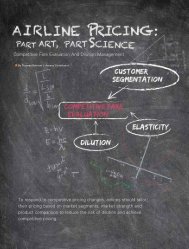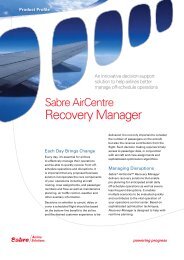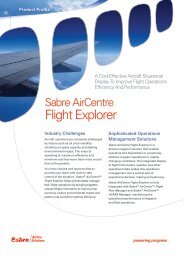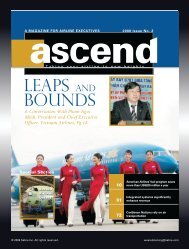2009 Issue 1 - Sabre Airline Solutions
2009 Issue 1 - Sabre Airline Solutions
2009 Issue 1 - Sabre Airline Solutions
Create successful ePaper yourself
Turn your PDF publications into a flip-book with our unique Google optimized e-Paper software.
camelina, an energy crop. This also represented<br />
the first biofuel demo by an Asian carrier as well<br />
as the first biofuel demo using Pratt & Whitney<br />
aircraft engines.<br />
The demo flight effectively brings the<br />
airline industry closer to finding a commercially<br />
viable second-generation biofuel that could help<br />
reduce the impact of carbon dioxide emissions<br />
generated by aviation, while also reducing the<br />
industry’s reliance on traditional petroleum-based<br />
fuels. The test conducted on Jan. 30 involved<br />
a blend of 50 percent biofuel and 50 percent<br />
traditional Jet-A (kerosene) fuel in one of the four<br />
Pratt & Whitney JT9D engines of a JAL-owned<br />
Boeing 747-300 aircraft.<br />
The biofuel component was a mixture<br />
of three second-generation biofuel feedstocks:<br />
camelina (84 percent), jatropha (less than 16<br />
percent) and algae (less than 1 percent). JAL,<br />
Boeing, Pratt & Whitney, and Honeywell’s UOP<br />
have committed to the use of second-generation<br />
biofuel feedstocks that represent more efficient<br />
and sustainable energy than their first-generation<br />
predecessors.<br />
Second-generation biofuel feedstocks,<br />
such as camelina, jatropha and algae, do not<br />
compete with natural food or water resources and<br />
do not contribute to detrimental environmental<br />
activity such as deforestation.<br />
The fuel for the JAL demo flight was<br />
successfully converted from plant-based oil to<br />
biofuel by Honeywell’s UOP, using proprietary<br />
hydro-processing technology to complete the fuel<br />
conversion. To create the 50 percent blend, the<br />
biofuel was then blended with typical jet fuel.<br />
Subsequent laboratory testing by Boeing,<br />
UOP and several independent laboratories verified<br />
that the blended biofuel meets industry criteria<br />
for jet-fuel performance. Ground-based jet-engine<br />
performance testing by Pratt & Whitney of similar<br />
fuels further established that the biofuel blend<br />
either meets or exceeds the performance criteria<br />
in place for commercial aviation jet fuel today.<br />
At Tokyo’s Haneda Airport, JAL Group<br />
companies have also been working together with<br />
the Japan Civil Aviation Bureau and a group of<br />
other companies in testing biodiesel fuel that has<br />
been refined from waste tempura oil collected<br />
from restaurants.<br />
As part of the trials, JAL has tested the<br />
novel fuel in one of its tug vehicles, which is most<br />
commonly used to transport heavy loads around<br />
the airport and for baggage transportation. In<br />
using a 50/50 mixture of light oil and biodiesel fuel,<br />
no modification of the tug was necessary.<br />
Being a member of a global airline industry<br />
has also enabled JAL to play some unique roles in<br />
fostering environmental improvement. Because<br />
forests theoretically mitigate the effects of such<br />
challenges as global warming by absorbing CO 2<br />
emitted through the burning of fossil fuels, JAL<br />
has supported the Boreal Forest Fire Control<br />
Initiative and other similar projects.<br />
With the overall aim of preventing or at<br />
least effectively containing wildfires through early<br />
detection, information gathering and analysis,<br />
JAL’s pilots flying over vast open regions including<br />
Indonesia, Siberia and Alaska have been reporting<br />
any fire outbreaks they happen to spot, with more<br />
than 700 blazes reported in the past six years.<br />
Since 1993, JAL has also been participating<br />
in a global-warming observation project,<br />
monitoring greenhouse gases in the upper atmosphere<br />
using specially fitted air-sample-collection<br />
and -measuring equipment. The program now<br />
involves five JAL aircraft on international routes,<br />
measuring the CO2 concentration in the upper<br />
atmosphere.<br />
The data collected using JAL aircraft are<br />
helping scientists study and better understand the<br />
causes and effects of measurable increments in<br />
global warming and overall climate change.<br />
And beyond JAL’s own regular air transportation<br />
activities, the carrier has been supporting<br />
the Japanese government’s energy-saving “Team<br />
Minus 6 Percent” initiative by reducing levels of<br />
office heating during the winter and office cooling<br />
during the summer, cutting CO2 emissions at<br />
JAL’s offices in Japan by more than 10 percent<br />
during the last five years.<br />
Also in support of the campaign, JAL has<br />
shown a Team Minus 6 Percent public-information<br />
video on its domestic flights, making a sincere<br />
appeal to members of the general public to consider<br />
ways they use energy in their everyday lives<br />
and encouraging them to economically use and<br />
conserve energy in every way possible.<br />
As company policy, JAL is also applying<br />
innovative flying and routing techniques including<br />
tailored arrival and user-preferred route to allow<br />
its aircraft to arrive at their destinations while<br />
using the least amount of fuel and producing the<br />
fewest CO2 emissions in the process.<br />
Additionally, JAL has instituted a voluntary<br />
customer carbon-offset program, enabling its<br />
passengers to purchase credits that are spent<br />
specifically on environmental procedures that<br />
effectively offset passengers’ individual measures<br />
of carbon generation during that particular<br />
trip.<br />
Furthermore, JAL’s commitment to finding<br />
and eventually introducing biofuel alternatives<br />
to conventional fossil fuels in its aircraft and<br />
ground vehicles represents a trailblazing effort<br />
for commercial aviation, essentially helping make<br />
commercial aviation the first global-transport sector<br />
to place verifiable sustainability practices in its<br />
fuel-supply chain.<br />
All of these and more measures are key<br />
elements of JAL’s equation to do its part in helping<br />
substantially improve the global environment.<br />
“As a symbol of our commitment to the<br />
environment, we operate an airplane with a green<br />
tail — and all employees are sharing in the effort<br />
to accelerate and carry out specific environmental<br />
activities,” Nishimatsu said.<br />
In the actions of its top executives and others<br />
throughout the organization, the JAL Group has<br />
exhibited a level of determination that may even be<br />
unique in worldwide corporate business circles to<br />
seriously combat the possible long-term detrimental<br />
effects of potentially harmful emissions and to<br />
leave a much more healthful environment as a<br />
genuine legacy to future generations. a<br />
Phil Johnson can be contacted at<br />
wearelistening@sabre.com.<br />
As part of its environmental sustainability strategy, JAl continues investing in new,<br />
more-efficient aircraft, such as the Boeing 787, which under normal conditions is estimated<br />
to burn 20 percent less fuel than current comparable aircraft.<br />
Photo courtesy of Boeing<br />
ascend 11<br />
profile
















